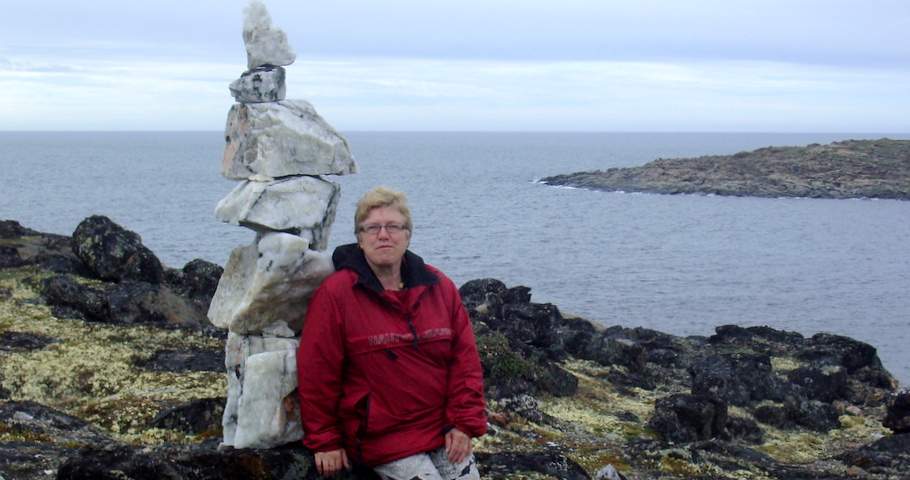Working together nation to nation is possible
I have read, and have come to believe, that with travel comes an extra bonus, a "value added" belief that working together nation to nation is possible. The more I step out of my comfort zone and my old set of pre-conceived notions, the more open I am to seeing what is, with acceptance and grace, the more I witness everyday living in other parts of Canada, the more I see WE are all the same.The old identity breaks down
Walking bends your mind, assaults your body, floods your senses, and shreds your nerves. From the moment you step off into the unknown, your old identity breaks down and you have to walk on without it. It’s this breakdown and the attendant possibilities for transformation—more than a specific teacher or spiritual site—those are the real blessing walking has to offer.Chatting with a local person about life in their world
I would never have guessed that I would walk barefoot sometimes. I would not have believed I could sit in a shop for two hours not buying, just chatting with a local person about life in their world. I would not have met the spiritual people that brought tears to my eyes and an opening of my soul. I would not have truly understood the lessons of family, respect and kindness if not for my friend Sharon, who told me her story. I would not have seen an incredible pride and respectful skill of small children had I not gone to the Victoria May 24th parade.Faced with an apparent paradox
To live with a vision I am faced with an apparent paradox-remaining flexible while finding creative ways to integrate others’ dreams with my own. I ask myself: how does my vision allow for diversity?Why think about the Inuit?
More information should be disseminated. Largely ignored, the Inuit live with situations affected by isolation due to geography. Many Aboriginal communities have similar situations to that of the Northern people. Yet there are differences. It is these aspects unknown to the general public that gives me the motivation to speak of their context.
This is an issue for all Canadians. But in some indigenous communities, men are rarely, if ever, assessed for failure to protect. Even when a child has two parents, “neglect” investigations focus primarily on the mothers. Child protection workers routinely engage with mothers and ignore fathers and father figures even when fathers are the identified source of a family’s difficulties. I saw this in action in Nunavik. When I worked with them, I was confronted with a structure that had too much red tape bringing with it many walls for the Inuit women; so much oversight that women did not get the benefits of justice; too many high end players with their own agendas and too well written scripts emphasising the importance of child protection to the exclusion of understanding the family context.
Inuit seek to find solutions to their problems
No road connects the Northern communities of the Nunavik region between them or to southern Canada. Air transport provides links throughout the year. Non-perishable food and other necessary goods are transported by ship during the summer. Locally, Inuit rely on snowmobiles, ATVs and motor boats for hunting, fishing and trapping and to visit members of their families in neighbouring communities.
Today's new reality does not mean that the values of Inuit from the family have been forgotten. Inuit must revive these values and reinvigorate them taking into consideration that social problems are more complex today and that families need new tools. Inuit have always been hardworking and persevering people who have a great ability to adapt and they seek to find solutions to their problems.
The transition between the traditional lifestyle and modern lifestyle
In the traditional economy, Inuit fully participated in the activities, they shared the tasks for the good of the family and the extended family and taught young people the skills and the essential social norms for survival. The transition between the traditional lifestyle and modern lifestyle has had a major impact on northern Aboriginal.
Inuit values that should be brought back
Inuit values that should be brought back or simply invigorated for the well-being of Inuit communities. Change must be rooted in the communities and supported by services designed and delivered by their own people. More than ever, parents and leaders at the local and regional levels need to become real-life role models for youth and instill pride in being Inuit, the strength to persevere and the confidence to succeed.
But the children are very vulnerable when they are removed from their birth families. When they are removed not only from their families but from their community, children lose out on being raised by their own families, in their own communities. As a result, there are increased numbers of Inuit children in child and foster care.
No Child Should Have to Take the Long Way Home
Children, mothers and communities are the objects of this project No Child Should Have to Take the Long Way Home. After all, every child is born with the right to have a better chance at a life free from abuse and violence.But the children are very vulnerable when they are removed from their birth families. When they are removed not only from their families but from their community, children lose out on being raised by their own families, in their own communities. As a result, there are increased numbers of Inuit children in child and foster care.








No comments:
Post a Comment